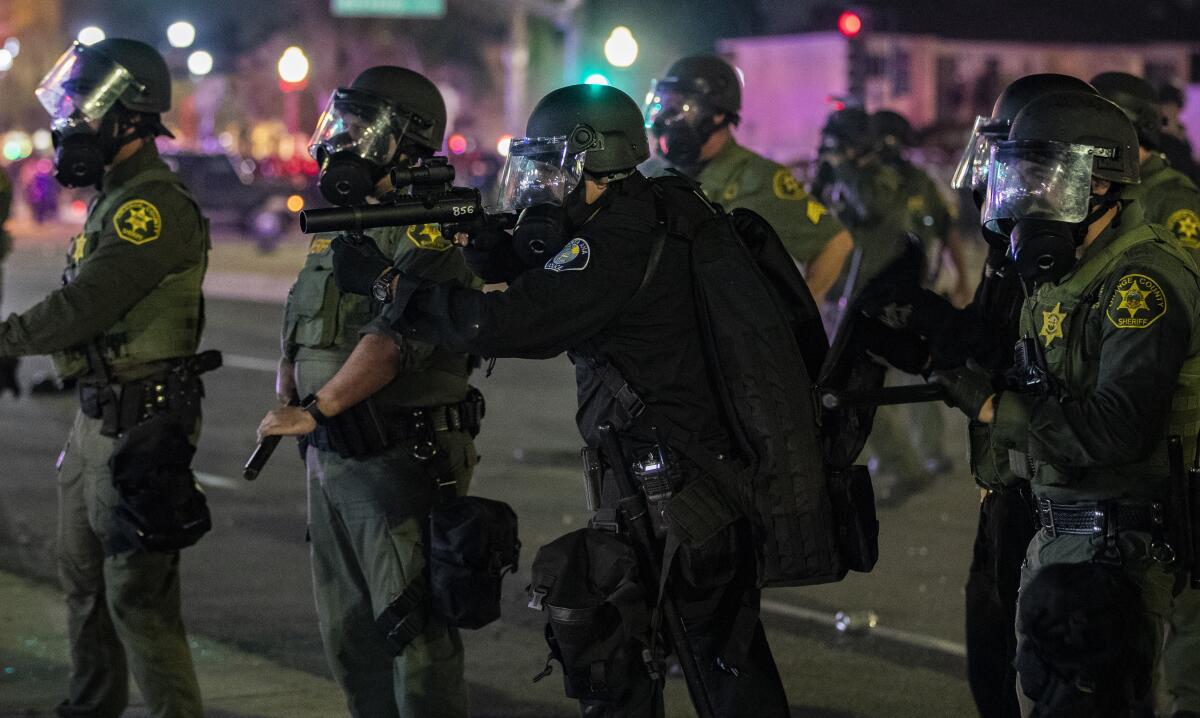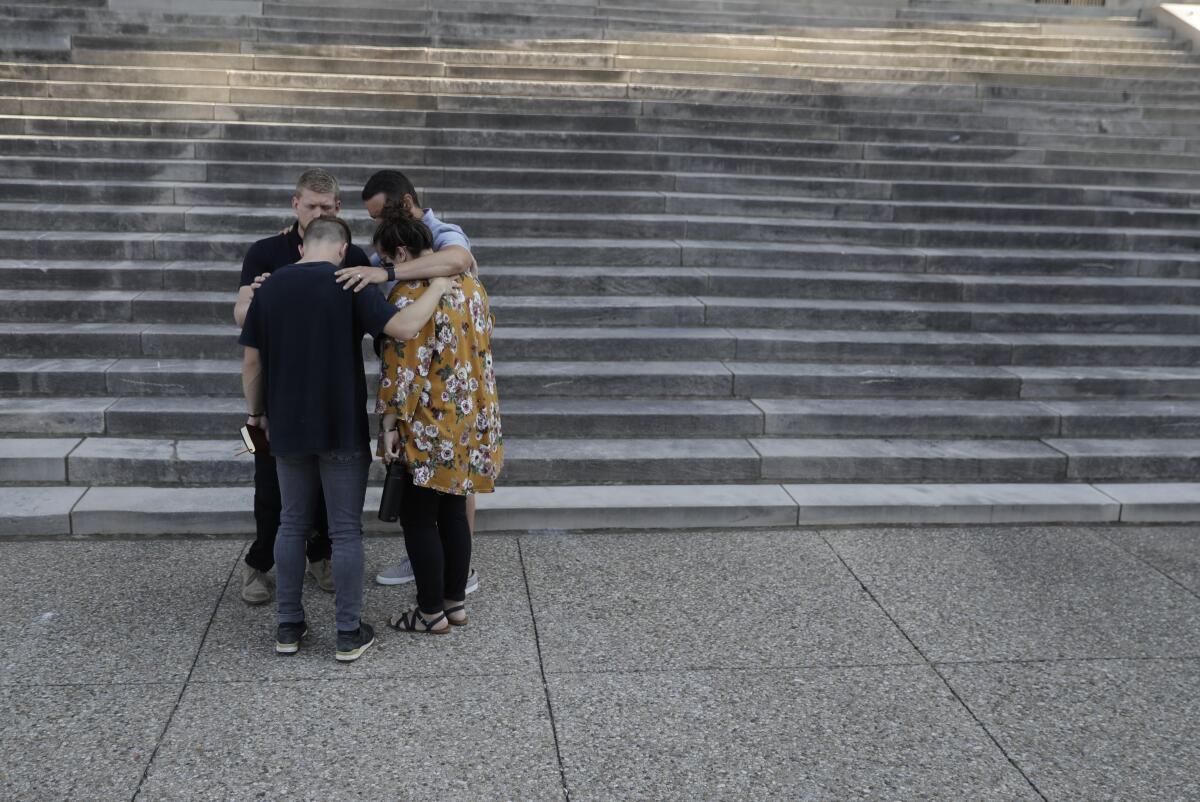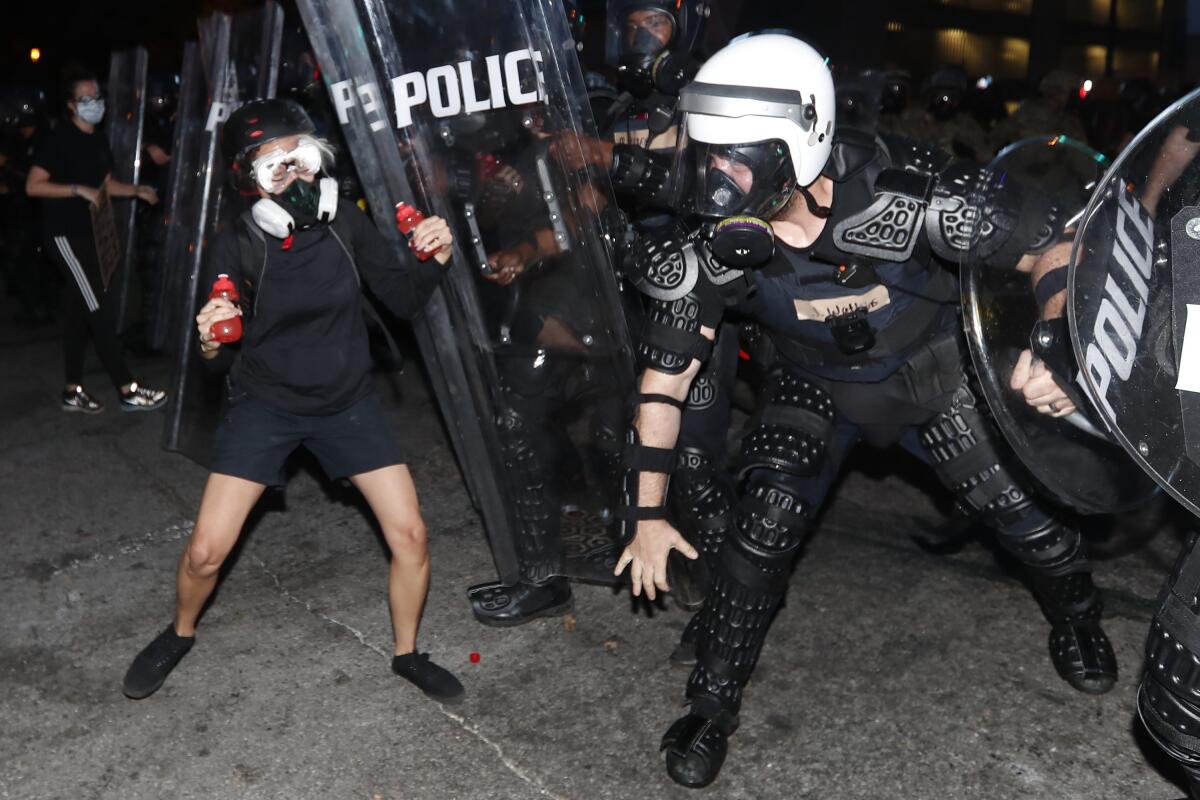‘We may descend into a dangerously failing country’: Police militarization amid protests spreads concern

- Share via
ATLANTA — Officers swarmed around a sedan driving slowly near a downtown protest and demanded that the two black college students inside get out.
“Open the goddamn door!” an officer shouted.
“No, I don’t know what’s going on,” the young woman pleaded.
As she started to exit the car, an officer, in riot gear, pointed a stun gun at her and fired. A different officer shattered the driver’s side window and tased the young man behind the wheel. His body shook and went limp.
Atlanta’s mayor swiftly condemned the tactics and fired two of the officers within 24 hours. On Tuesday, three days after the incident, arrest warrants were issued for six officers. But by then, hundreds of thousands of people had watched video of the encounter, further stoking the outrage many protesters feel over the state of policing in America.
In the days since demonstrators began filling the country’s streets, demanding justice for George Floyd, an unarmed black man who died in police custody, law enforcement agencies and the protesters they are trying to control have deployed varying tactics in what has turned into a national drama on race and the growing mistrust of public institutions.
In some cities, including Atlanta and Houston, police chiefs spoke directly with protesters. Officers in other cities knelt in solidarity with the crowds. But night after night, as largely peaceful gatherings often devolved into looting and arson, other striking, more militaristic scenes veered across TV screens and Twitter feeds.

Images told of a nation at conflict with itself: Tanks barreled through city streets. National Guard troops in camo patrolled with assault-style weapons slung over their shoulders. In several cities, protesters and journalists bled after officers fired rubber bullets into the crowds. Protesters in Philadelphia, who had just been tear-gassed by police, screamed out, “I can’t breathe” — the same three words Floyd uttered before he lost consciousness as a white officer’s knee pressed into his neck.
As days passed and rage intensified, protesters in a number of cities lashed back at police. An officer was in critical condition Tuesday after being shot near the Circus Circus Hotel and Casino in Las Vegas as the police tried to disperse crowds that were pelting them with bottles.
“With these protests, which are leading to riot,” Clark County Sheriff Joe Lombardo said, “one tragedy is only leading to another.”
Four police officers in St. Louis were struck by gunfire in late-night protests that turned deadly. Their injuries were all non-life-threatening. Such an atmosphere has again exposed a polarization over law and order, and a suspicion many black and brown people have for institutions rife with racism in housing, healthcare and criminal justice.
Voices in the discord include those who support the cops in a battle between looters and authority — some even say police have been too hands off as small businesses have faced millions of dollars in damage. Ultimately, the images and videos of officers’ behavior at protests against police brutality, where they know that they are being recorded, have further stoked frustrations and divisions over policing in America.
On Monday, in the shadow of the White House, military police dressed in riot gear fired rubber bullets, flash-bang grenades and tear gas canisters into a peaceful crowd. As President Trump sees it, a show of force from police was not only appropriate, but also necessary. Minutes after protesters were tear-gassed, Trump vowed to deploy “thousands and thousands of heavily armed soldiers, military personnel and law enforcement officers” to American cities.
An escalation, he said, was necessary to end the civil unrest.
But Jim Coleman, a law professor at Duke University, says that is the wrong move.
“This will all head south if governors and local officials take Trump’s advice and use overwhelming force to end the demonstrations,” said Coleman, who leads the school’s Center for Criminal Justice and Professional Responsibility. “We may descend into a dangerously failing country.”

Police enforcing a curfew violation in Louisville, Ky., early Monday morning shot and killed a black restaurant owner after he apparently fired on them. Leaders called for the body-camera footage to be released, but the city’s mayor revealed the officers had not activated their cameras. The mayor fired the police chief, who was already set to resign. About 370 miles east in Richmond, Va., the police chief said officers who used tear gas on a group of peaceful protesters would be disciplined.
In Atlanta, the police department has seemed to vacillate between opposite tactics: heavy-handed shows of force and a step-back-and-listen approach. The department has prided itself in recent years on working to develop a less antagonizing presence with protesters — policing marches and demonstrations remotely, via CCTV cameras, and having officers wear regular beat uniforms, rather than militaristic garb.
Then, this weekend, video of the Atlanta officers surrounding the college students, smashing the car window and yanking the woman from her seat went viral. Fulton County Dist. Atty. Paul Howard announced that six officers will be charged with aggravated assault stemming from the incident with the college students.
“It is not indicative of the way that we treat people in the city of Atlanta,“ Howard said.
On a recent afternoon, Andrew Goodman, a 48-year-old high school teacher, paused as he rode his bike at Atlanta’s Centennial Olympic Park and thought about the moment, another chapter in the nation’s political divisions and cultural wars.
“Trump is definitely stoking violence,” he said, adding that the president’s speech “stunk of totalitarianism and governmental terrorism” and was a stark contrast to the symbolic olive branches the country witnessed as a sheriff in Michigan marched with protesters and police officers in his hometown knelt.
After watching more of the speech, he said he worried about Trump’s reference to the 2nd Amendment.
“Definitely a subtle call to arms for his alt-right base,” Goodman said.
In St. Paul, Minn., not far from where Floyd died in police custody, protesters gathered Tuesday at the foot of the state Capitol. The gatherings are an outcry, said Wakpor Rangel, who works for the Special Olympics.
“It speaks volumes to how broken our country is,” said Rangel, who is black. Her husband, Zach, who is white, stood nearby carrying a sign that read, “My wife is not a threat.”
Minutes later, a man with a bullhorn shouted, “Is anybody else out there scared?”
The crowd cheered, then started chanting, “Enough is enough.”
In neighboring Minneapolis, Jerry Starr, 59, was happy to see a strong police presence. After several days, he had finally gotten a good night’s sleep Monday. Other nights, he said, he’d been staying up guarding his car lot from looters, who he said had gutted the neighborhood and ransacked a liquor store and Target, and set a pawn shop on fire.
“Since the military and the police could respond, everything has been good,” he said. “It went from chaos to order.”
Police in the 1950s and ‘60s were — by comparison — more aggressive against civil rights and anti-Vietnam war demonstrators. The militarization of police officially began in the 1970s during the “war on drugs.” America was reminded of that six years ago when heavily armed officers in riot gear marched through the streets of Ferguson, Mo., during protests after 18-year-old Michael Brown was killed by a white police officer.

President Obama issued an executive order in January 2015 that imposed some limitations on the transfer of military equipment to police departments around the country. But two years later Trump, who campaigned as a “law and order” president, reversed the Obama-era mandate.
A bipartisan group of lawmakers has renewed a push to shut down a Pentagon program that transfers military weaponry to local law enforcement departments.
Back in Atlanta on Tuesday, Sedio Stuart, a 22-year-old art student and photographer who has protested in recent days said that police were operating much more aggressively than they did on her first protest last week.
Two of Stuart’s best friends were injured over the weekend when police fired paintballs and rubber bullets into the crowd.
Trump’s talk of deploying the military, she said, was only exacerbating the conflict.
“He doesn’t really care why we’re protesting,” she said. “He doesn’t really want to hear us out. He just wants to get us off the streets.”
Lee reported from Los Angeles, Jarvie from Atlanta and Hennessy-Fiske from St. Paul, Minn.
More to Read
Sign up for Essential California
The most important California stories and recommendations in your inbox every morning.
You may occasionally receive promotional content from the Los Angeles Times.
















